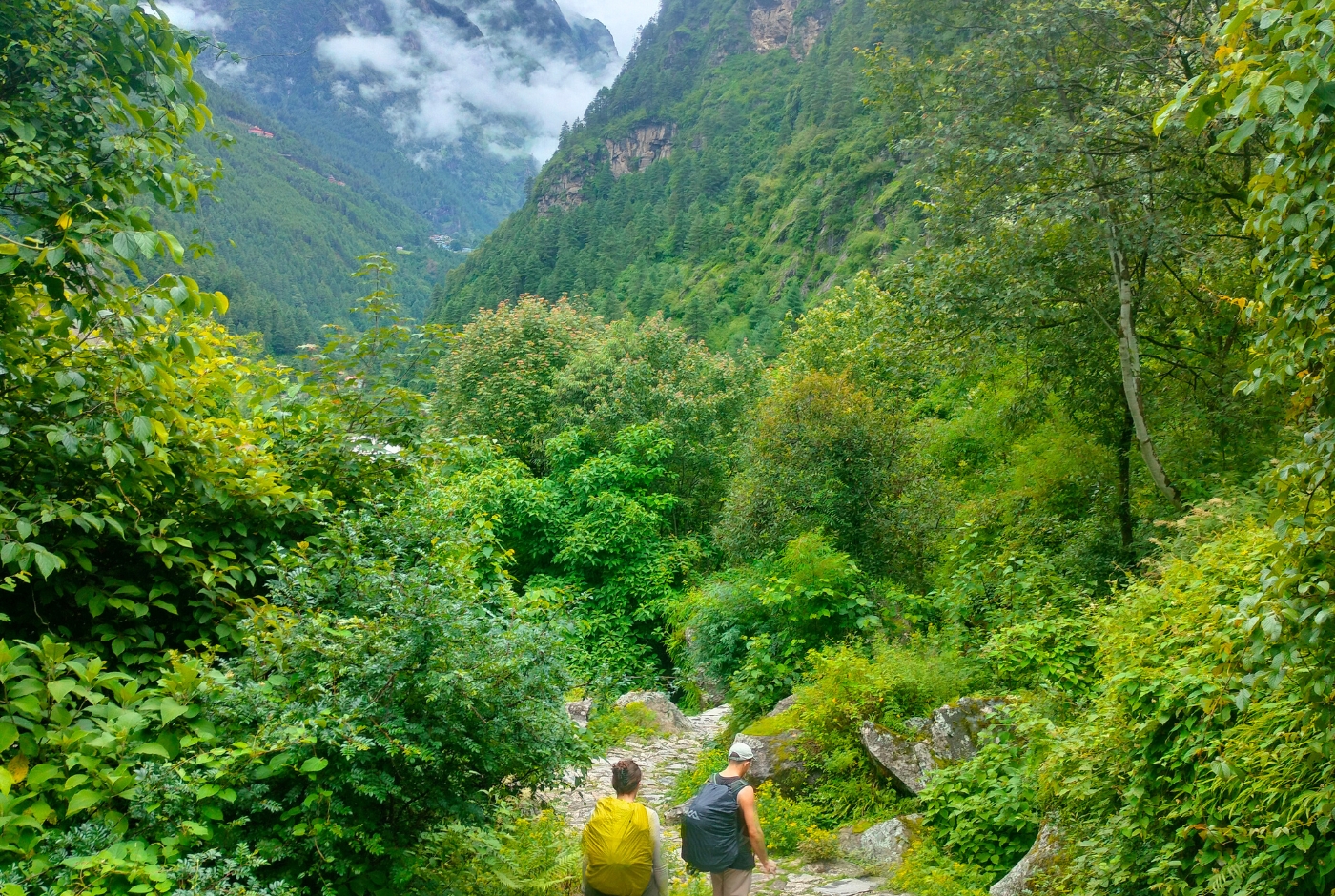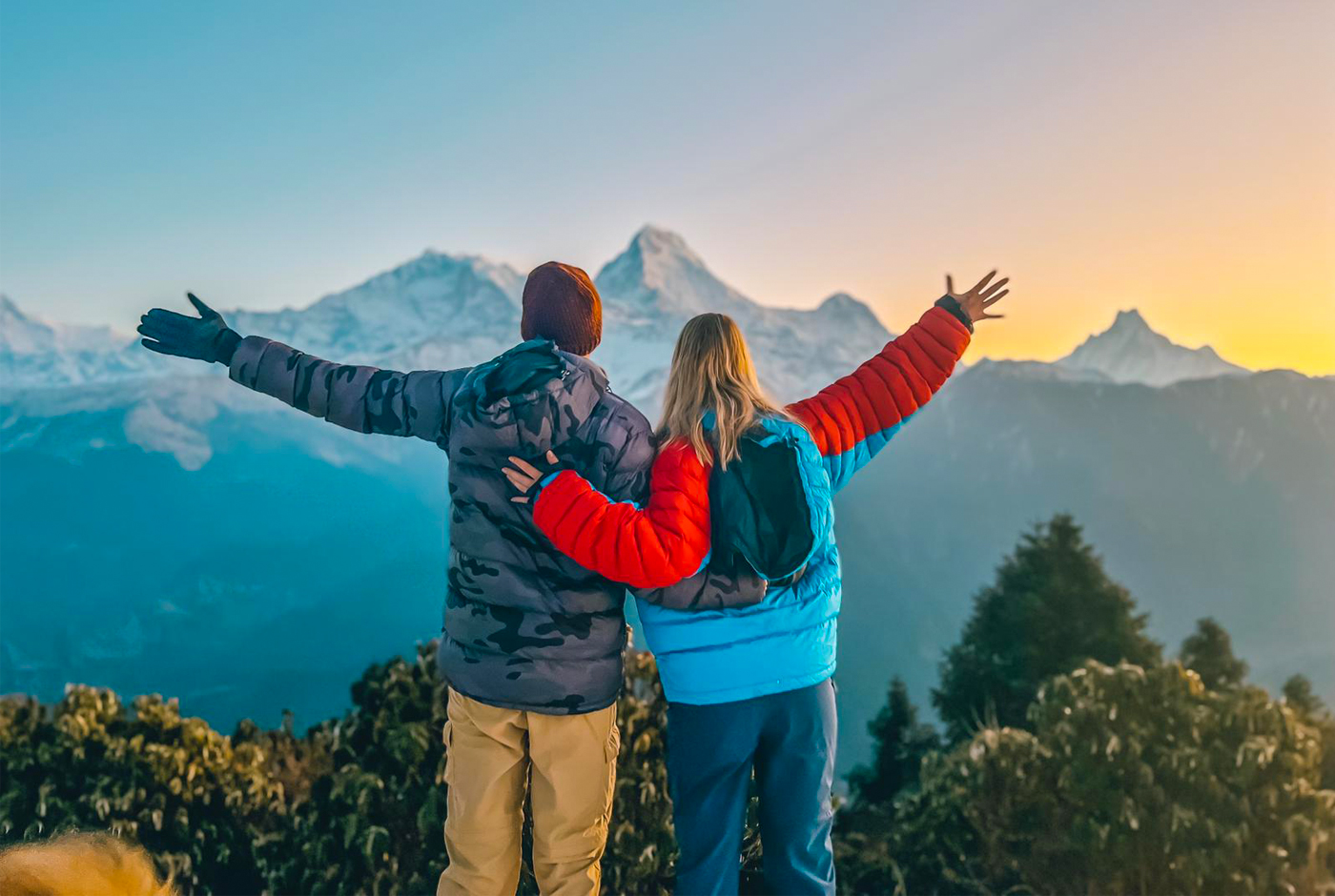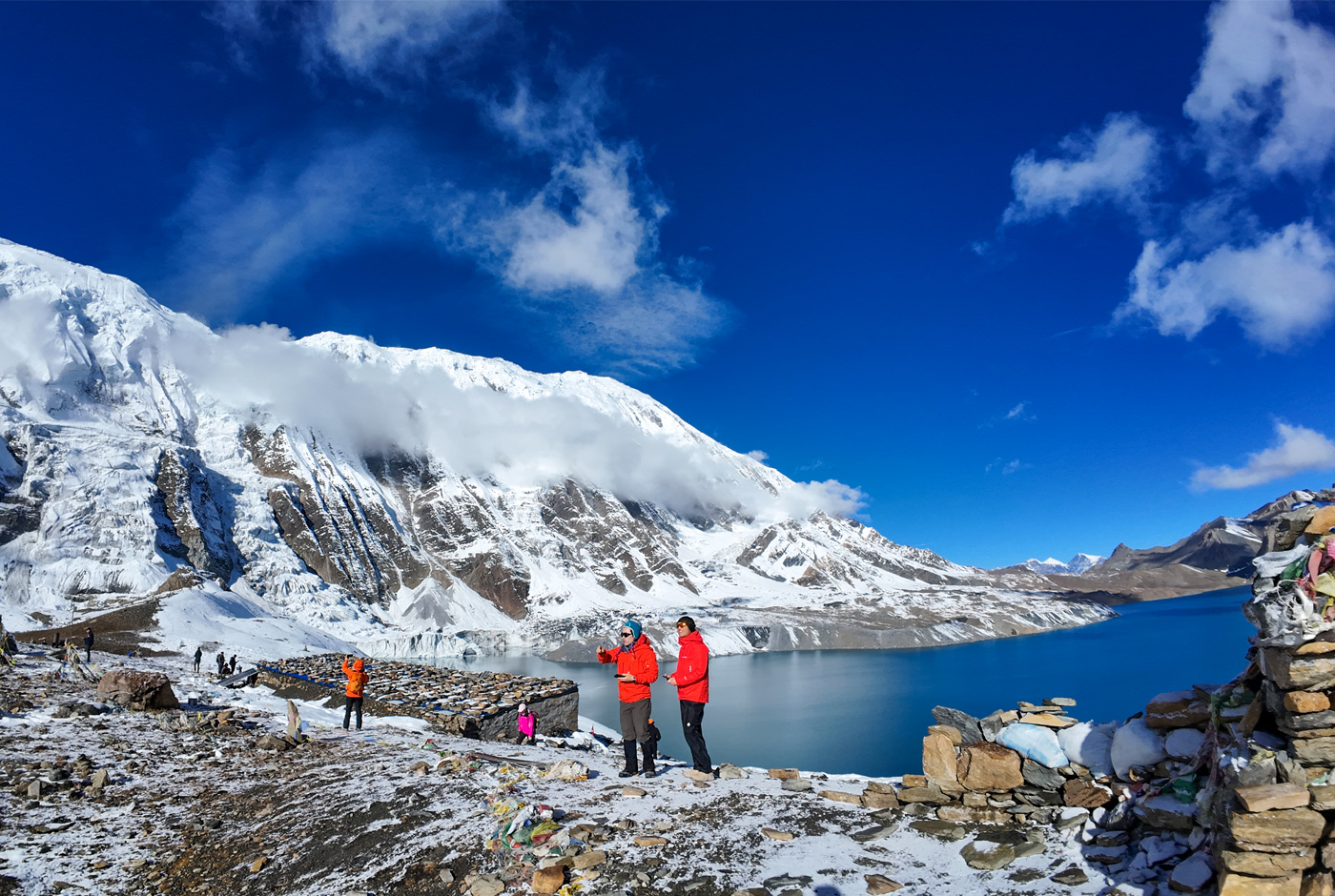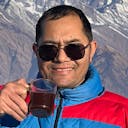- When is the best time to visit Kathmandu?
- Below are Nepal's best trekking seasons:
- Pros of trekking during Spring
- Cons of trekking during Spring
- Pros of Summer/Monsoon Season for Trekking
- Cons of Summer/Monsoon Season for Trekking
- Pros of trekking in Nepal during autumn
- Cons of trekking during autumn
- Pros of trekking in Nepal during Winter
- Cons of winter trekking in Nepal
The best time to trek in Nepal is not limited by time; trekking trails in Nepal is like floating along in a paradise not bound by any time so take a new energized soul back home with treks in Nepal.
AND come and feed your wanderlust with a visit to Nepal!
A visit to Nepal will be a beautiful thing, and with this visit comes trekking to the beautiful destinations of Nepal. Whether young or old, an expert or an amateur, a trekking trail will be perfect for you to explore. So, next time you're pondering your dream holiday, book your unique getaway to the extraordinary with Nepal Hiking Team.
Nepal has tremendous variations in climate, with the highest mountains in the world and a splendid, lush landscape. The lowlands are tropical, the midland hills are temperate, and the high mountains have icy weather. The fall and the Spring offer clear, bright views of the mountains.
There’s no better time for trekking in Nepal; you can trek any time of the year, but different trekking destinations depend on the route and geography of the Himalayas. Spring and fall are good seasons to trek in Nepal.
Choose your perfect season, pick your trekking date, call your friends, rally your mates. Join Nepal Hiking Team for 2025/26—The perfect time for a marvellous trek
When is the best time to visit Kathmandu?
An ideal time to visit Kathmandu is anytime between late September to December, although the weather is pleasant all year round. The pristine views of the mountains, festivals, and pleasant weather adds up to the best time to explore this city, with many heritage sites listed by UNESCO. The temperature during this time generally ranges from 25-degree celsius to 14 degrees. Likewise, the weather is perfect during this time for local hikes, and you can hike to many nearby hiking destinations located near the valley. Like any other touristy place in Nepal, the capital city is vibrant, with plenty of opportunities to enjoy the green hills and beautiful local scenery.
Below are Nepal's best trekking seasons:
Spring Peak Season: February, March, and April
Spring is the best season to visit or trek in Nepal is the Spring, from late February through April. The temperature in the Spring is similar to fall when the trails are less crowded with travelers.
The spring temperatures are similar to the fall, with slight haze and precipitation. And the trails are less crowded, but for a good mountain view reaching a good altitude point of around 10,000 feet is recommended. Spring is the second pick after autumn for trekking, a great time to enjoy your trek to the gigantic Himalayas. Spring is also ideal for mountaineering, peak climbing, and expeditions, with the magnificent view of the rhododendron forest making your trial journey worthwhile. Although Spring offers a good time for trekking, it may not always come with warm temperate weather.
Now, why choose the Spring season for trekking in Nepal? Let's understand the pros and cons of this season.
When to go Trekking in Nepal: Spring Season is one of the best time to trek in Nepal

Pros of trekking during Spring
- Trekking this season involves little or no risk—a good time for trekkers to enjoy their strenuous journey.
- Enjoy the beauty of being a true adventurer with various outdoor activities possible during this season.
- The weather is pleasant, with the weather being brittle in the morning and pleasant during the day.
- The stunning view of the pink bloom of rhododendron that covers the green forest
- will captive your soul.
- The weather conditions are tolerable, with temperatures ranging from 16 to 23 degrees in the higher altitudes and low lands.
- A fine weather conditions to summit the majestic Mount. Everest.
- There are fewer travelers than in the autumn season, with more possibilities to explore the corners of the Himalayas.
- By April, Cho La, Larkya La, or throng La, the snow condenses away, clearing a path for trekking over 5000 m altitude.
Cons of trekking during Spring
- Popular trekking destinations like Annapurna Base Camp, Ghorepani, and Poon Hill may get crowded. However, you always have the flexibility to choose other trekking destinations with lesser travelers during this time.
- The weather will likely get hotter, creating problems for several trekking hours, especially in lowlands or altitudinal regions.
- An occasional downpour of snow and rain at a higher altitude is possible.
- Local teahouses and accommodations might be fully booked and overcrowded due to the busiest time of the trekking season.
- Difficulties in carrying backpacks as you climb higher altitudes because it starts getting cold and treacherous, sometimes windy too.
Monsoon: May, June, July, and August
The monsoon or the summer season from May until August is no less an ideal time for trekking, with lower-elevation hills like Mustang and Dolpo as exceptions. During this time, you may face a significant amount of heat, haze, and rain due to the rising temperature in the Indian Ocean. You may struggle to get a good mountain view, leading to difficulties in trekking on muddy trails and a lack of good transportation. The peak monsoon season begins in July when the weather slowly tapers into a drier fall season.
Is summer timr best for trekking and hiking in Nepal?

The Summer or monsoon season can be Nepal's most energizing trekking season. Regardless of the weather condition during this time, it has its appeal. The summer season isn't ideal as it may be highly sweltering in Nepal's terai and hilly regions. However, the weather is soothing and pleasant enough in the mountains, which are neither too hot nor cold. The monsoon weather conditions may expose a certain level of challenges with storms and landslides.
Moreover, the ambiance during this time is pretty charming, with greenery and various blossoms. The sunny summer weather may rise to 30 degree Celsius in the capital city, Kathmandu, and the Terai region. The monsoon rain makes the trail sloppy and muddy, and risk of leeches for trekkers. The downpour during this season has its advantages and disadvantages, like frequent landslides, obstructions in travel, and a beautiful view of a waterfall. Besides, the trekking destinations of the Trans Himalayan region, like Upper Mustang, Upper Dolpo, and Narphu trekking, are often appreciated in impeccable climates.
Just like the winter season, the Summer or the Monsoon season in Nepal has both pros and cons, which I would like you to read for further details if you are thinking of trekking in Nepal during this time of the year.
Pros of Summer/Monsoon Season for Trekking
- Fewer travelers, which means the trekkers can enjoy the trial in solitude.
- Less dust because of the monsoon rain.
- The view of the Himalayas after the downpour is simply amazing.
- There are discounts on booking trekking destinations and accommodation.
- The valleys are insanely green and beautiful, which gives a good picture.
- The teahouses are less crowded and reasonably priced.
- The accommodation and food are affordable enough due to the off-season.
- You will have an opportunity to see assortments of blossoms.
- You can make your booking at the last minute due to the off-season.
Cons of Summer/Monsoon Season for Trekking
- The sweltering climate makes the journey odd.
- The trail is infested with leeches.
- There are fewer chances of meeting other trekkers from around the globe.
- Fewer animal sightings.
- Prone to landslides, storms, and harsh weather conditions.
- Obstruction in travel.
Fall Second Peak Season: September, October, and November
September through November are peak trekking seasons in Nepal: temperatures are mild, the weather is relatively stable, and the bright clear skies make the mountain views more visible with stunning views. At higher altitudes, the mountains are cold at night, with warm temperate weather conditions during the daytime. Because the weather can worsen at any time, fall is still considered an ideal season to visit or trek in Nepal. The trekking condition can get busier, most trekking destinations, such as Everest Base Camp and the Annapurna Circuit, may be crowded with trekkers, quite noticeable in local teahouses.
Thamel, the hub of tourists, is the busiest area of the capital city, and fall is when the trekking guides charge the most. However, these guides charge relatively less at other times.
Best time to visit Nepal after spring is Autumn

Pros of trekking in Nepal during autumn
After the monsoon, autumn brings the best of Nepal's beautiful landscape when the clear sky and a mild breeze bring a different aroma to your trekking journey. Here are a few reasons that make autumn a good season for trekkers:
- The snow-capped mountains are visible and, most notably, favorable weather for trekking.
- Mesmerizing views of dazzling lakes and green pastures are possible when the weather is more pleasant.
- The Autumn season is the time for festivals in Nepal, so it's an opportunity to get insights into Nepal's rich cultural aspects and adventurous trekking journey.
- There is a low risk associated with danger and unfortunate incidents. Autumn has suitable weather conditions with less risk of snowfall, landslides, storms, avalanches, or other unpredictable disasters. With more predictable climatic conditions during this time autumn season is often considered to be the best that involves less risk to the trekkers.
- Autumn is the busiest time for trekking, so you will meet many trekking buddies from all over the world who will share this adventurous journey with you.
- Fewer crowds in early September until mid-September is just another reason.
Cons of trekking during autumn
Now, with the pros comes the cons, so this season has a few cons.
- The trekking trail is usually busy and crowded, with local teahouses being packed, and the trekking trail becomes excessively crowded, which many might not like.
- In higher altitudinal trekking zone, the temperature becomes low after sunset, making it freezing.
Winter or the Shoulder Months: December, January, and February
The months of December, January, and February is considered to fall in shoulder seasons with extreme weather conditions and involves more risk for trekkers. You can enjoy the peak season condition with only a fraction of the trekkers. The weather will likely be unpleasant if the winter comes early.
December in the Himalayan region is usually dry, with a clear sky mid-day; however, it may get freezing at higher altitudes. And by mid-December, the weather conditions become extreme and unbearable, with many closed local tea houses. You may require technical training and good physical condition to be able to trek at this time of the year.
Winter Trekking Season in Nepal

Because there are no unfavorable months to trek in Nepal, these months aren't the most suitable for trekking due to extreme weather conditions in the Himalayan regions of Nepal. The temperature reaching between 9-12 degrees Celsius during the day and dropping to zero after sunset may not be too favorable who don't like icy weather conditions that may likely bring a certain level of risk and inconvenience for trekkers. Moreover, you may consider it the ideal month to trek due to fewer travelers at this time and the possibility of warm weather conditions in the lowland valleys.
It will be untrue to say that winter isn't the best in Nepal. Winter has its charm, and it can be said it winter in Nepal is spectacular with varieties of winter trekking destinations. Although the coldest months of the year, it's rewarding to trek at this time, as it adds to your adventurous journey making it more challenging in cold weather. At this time of the year, your trekking journey makes you feel no less than a fantasyland with mountains and valleys fully covered with snow.
Many prefer spring and autumn seasons over winter. However, many trekking trails are suitable for winter or any time of the year. The Nepal Hiking team also offers you some of the best treks in Nepal during the winter so you can experience the beauty of the cold wintry season with splendid views of the mountains. So, if not Spring or Autumn, Nepal is always open for trekking at any time of the year.
The high passes, for instance, Thorong La (5416m) in the Annapurna region, Cho La (5335m), Kongma La (5545m), and Renjo La (5420m) in the Everest region, are regularly closed because of extraordinary snowing in winter.
The ways to these mountain passes are closed because of the day off. Trekking in the high mountain passes is as yet conceivable. However, adventurers should be prepared to confront a testing realm and be genuinely fit. Since the weather conditions become extreme during this time, it is important to get insights into the pros and cons of winter trekking in Nepal.
Pros of trekking in Nepal during Winter
- The incredible landscapes of the mountains.
- The incredible snow-covered landscape.
- Fewer travelers, making it less crowded.
- Favorable, clearer day temperatures with foggy mornings
- are worth experiencing.
- Good low-altitude trekking is excellent in winter.
- Visit Chitwan National Park and Bardia National Park to see unique wildlife. It's easy to spot the royal Bengal tiger and one-horned rhino during winter.
- Nepal Hiking Team offers optional winter trekking trails.
- Explore the lowlands and the terai regions, the most popular being Lumbini, Chitwan, and Bardia.
- Clear skies with chilly weather condition is another plus point.
- An opportunity to capture panoramic pictures and
Cons of winter trekking in Nepal
- The freezing temperature with testing weather conditions may pose difficulties for trekking.
- High chances of experiencing snow visual deficiency.
- Chances of losing the trail due to snow.
- Limited high-altitude trekking destinations.
- The risk of avalanches, although beautiful to see, maybe terrifying.
Pick your favorite trekking destinations at the disposal of your holiday time, and pack your bag as great holiday destinations like Nepal give you a change of scenery, and provide adventure, so totally unplug yourself from your mundane everyday routine.
While you might associate the Himalayas with snow-capped mountains, the best time is any time of the year to visit Nepal when nature is flourishing everywhere you go in all different seasons.
Still in doubt, which Season to visit and trek in Nepal 2025/2026? - Contact Nepal Hiking Team
Pack your bags for the Himalayas. No matter when you plan your visit — the weather will bring the best out of your visit. In general, you can get the best at the best seasons for trekking. So, everyone might not pick the best spring and autumn seasons to visit Nepal for trekking. Yet, for adventurous enthusiasts, any time of the year is the best, although autumn and Spring is the best times to enjoy the trekking season. It is absolutely unto individuals and their inclination.
And yes! Here, we are the Nepal Hiking Team to help you choose the right time to trek in Nepal.



